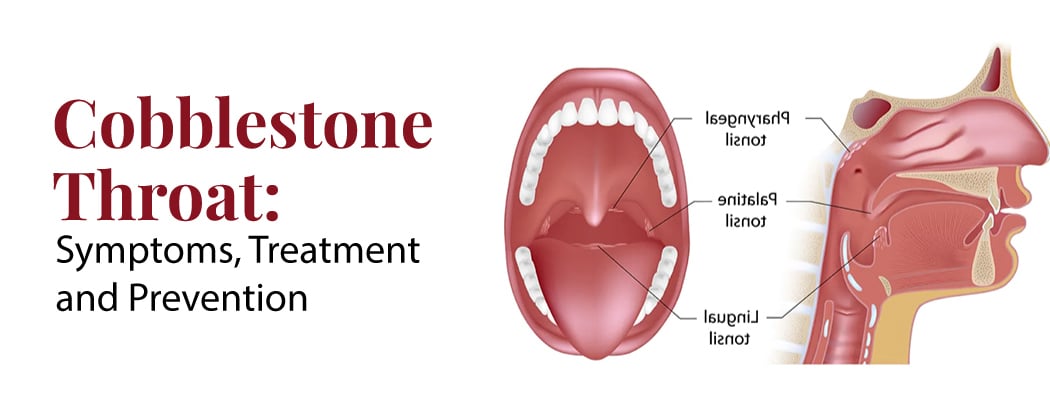From Symptoms to Solutions: Exploring Cobblestone Throat Treatment and Prevention
March 20, 2024

Cobblestone Throat
Excess mucus in the throat may cause a cobblestone throat to develop. Treating cobblestone throat involves addressing the underlying source of that excess mucus, such as allergies.
Contents
Understanding Cobblestone Throat
Adenoids and tonsils are glands in the back of the nasal canal that aid in filtering out bacteria and viruses. Enlarged lymphatic tissue in these glands can result in cobblestone throat.
When excess mucus accumulates in the back of the throat, these lymphatic tissues enlarge as a reaction from the immune system, causing lumps to form. The name “cobblestone throat” comes from the lumps’ resemblance to a cobblestone path.
When discussing sore throats or pharyngitis, medical professionals will occasionally use the term cobblestone throat.
Causes for Cobblestone Throat
Bumps in the back of the throat can be caused by a variety of infections and other ailments. Some of the infections can be:
- Viruses: The most typical reason for a sore throat is viral illness. Bumps on the back of the throat can be caused by the following viruses –
- viruses responsible for the common cold
- viruses causing influenza
- viral herpes simplex that causes chickenpox
- infectious mononucleosis (mono) croup
- Bacteria: The lumps at the back of the throat can also be caused by bacterial infections. This may occur after being exposed to the bacterial group A strep.
- Additional potential reasons include: breathing in dry air, allergies, postnasal drip, acid reflux.
Symptoms for Cobblestone Throat
The bumps typically resemble pebbles and appear red, itchy, or inflamed. Depending on the cause of cobblestone throat, other symptoms may include:
- dry cough that won’t go away
- sibilant voice
- nausea and vomiting
- foul breath
- a high temperature
- discomfort while conversing
- discomfort when swallowing
- irritable throat
- a feeling as though something is stuck in one’s throat
Diagnosing Cobblestone Throat
Cobblestone throat may usually be diagnosed by your doctor with a simple throat examination. They will also inquire about any symptoms other than the lumps. To determine if cobblestone throat is caused by a virus (which is the most prevalent) or bacteria, a throat culture is advised.
Preventing Cobblestone Throat
To avoid cobblestone throat, the following practices can be implemented:
- Recognize and stay away from things that make your allergies flare up.
- Avoid inhaling secondhand smoke, vaping, and smoking.
- Keep up a healthy lifestyle that consists of a balanced diet, regular exercise, seven to eight hours of sleep each night, and minimal stress.
- Avoid physical contact with sick people, mask or social distance yourself when necessary, and wash your hands often to prevent bacterial and viral infections.
- Follow doctor’s or healthcare providers’ recommendations when using allergy medicine.
- When sneezing or coughing, cover your mouth and nose with your elbow.
- Don’t share towels or cutlery.
- Keep surfaces clean on a regular basis.
Treating Cobblestone Throat
Depending on the underlying cause, cobblestone throat treatment varies. Antibiotics, which destroy germs and stop them from proliferating, are prescribed by doctors to treat bacterial illnesses.
Antibiotics cannot treat viral infections like the flu; instead, they typically go better on their own. Pharyngitis often goes away in seven to ten days.
The following natural therapies at home could aid with pain and relief from discomfort:
- consuming a lot of water
- relaxing
- consuming warm liquids, such as tea
- gargling with salt water
- sucking on a throat lozenge
- using nasal sprays to treat post nasal drip
Conclusion
The additional mucus in your throat causes cobblestone throat, which is nearly always a harmless condition. Although its uneven look may be concerning, there is no connection between it and any kind of malignancy. To begin treating the issue of excess mucus dripping down your neck, collaborate with your physician to identify the cause.
Frequently Asked Questions
1. Does cobblestone throat spread easily?
Although not communicative, cobblestone throat can arise from a communicable illness. For instance, you can spread bacteria-causing infections like strep throat or viruses like the flu that irritate your throat. Cobbler’s throat can be caused by bacteria or viruses, both of which are communicable. Certain causes, such as allergies or acid reflux, are not transmissible.
2. What should I anticipate if I have a sore throat?
If it was an irritation from the flu or a cold, the bumps should go away in a week or two. Acid reflux, allergies, or a more dangerous germ that your body is having problems fighting off could be the cause of a persistent cobblestone throat. Consult your physician if the bumps continue.
3. What causes a non-painful cobblestone throat?
Cobbler’s throat frequently, but not always, is accompanied by a sore throat. Even if your throat isn’t hurting, the common causes—colds, the flu, allergies, etc. may be to blame. The thickened tissue in your throat can potentially be an indication of another illness. See your healthcare professional for a precise diagnosis if your bumps don’t go away after a week or two.
4. Is cobblestone throat caused by post nasal drip?
Indeed. Similar to a runny nose, but with post nasal drip, it occurs in the back of the throat. Your tonsils and adenoids become irritated by the extra mucus, which causes the tissue to swell and become rough.
5. What is the best way to treat cobblestone throat?
Usually, within a week or so, cobblestone throat resolves on its own. Consult your healthcare professional if it doesn’t. Along with suggesting remedies, they can assist you in determining the cause of your cobblestone throat.







